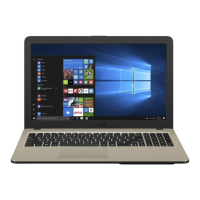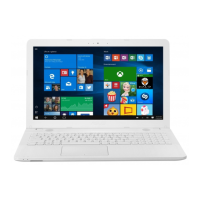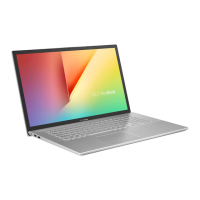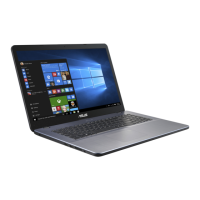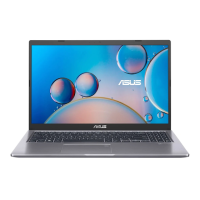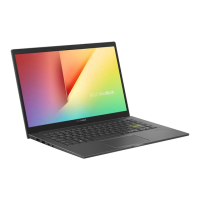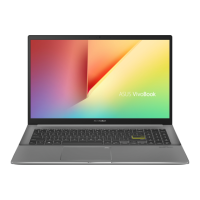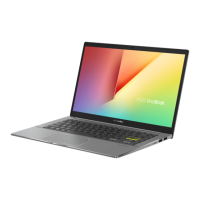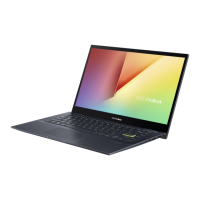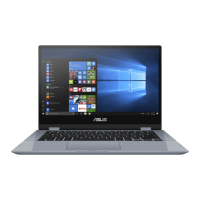Do you have a question about the Asus VivoBook X515 and is the answer not in the manual?
Details the components visible from the top of the notebook, including the display and keyboard.
Details the components visible from the top of the notebook, including the display and keyboard.
Provides an overview of the notebook's bottom side components and warnings.
Illustrates and describes the status indicators and battery charge indicators on the right side.
Details the ports and input/output connectors located on the left side of the notebook.
Guides on initial setup, including charging, opening the display, and pressing the power button.
Explains how to connect the power adapter and charge the notebook for the first time.
Covers basic pointer movement and single-finger gestures on the touchpad.
Explains the functionality of HotKeys, function keys, and Windows® 10 keys.
Details the function keys and their associated media and system controls.
Explains how to use the numeric keypad for input and pointer functions.
Guides through the initial Windows® 10 setup and configuration process.
Explains the Start menu as a gateway to programs, apps, folders, and settings.
Describes apps pinned in tiled format on the Start menu for easy access.
Covers launching, customizing, and closing Windows® apps using touchpad or keyboard.
Guides on connecting to Wi-Fi and Bluetooth networks.
Provides methods for shutting down the Notebook PC normally or via force shutdown.
Explains how to put the Notebook PC into sleep mode.
Explains accessing BIOS settings or running troubleshooting options during POST.
Provides methods for entering the BIOS settings from startup or Windows.
Explains system recovery options to restore or refresh the notebook.
Guides on accessing and using various recovery options within Windows.
Details the components visible from the top of the notebook, including the display and keyboard.
Details the components visible from the top of the notebook, including the display and keyboard.
Provides an overview of the notebook's bottom side components and warnings.
Illustrates and describes the status indicators and battery charge indicators on the right side.
Details the ports and input/output connectors located on the left side of the notebook.
Guides on initial setup, including charging, opening the display, and pressing the power button.
Explains how to connect the power adapter and charge the notebook for the first time.
Covers basic pointer movement and single-finger gestures on the touchpad.
Explains the functionality of HotKeys, function keys, and Windows® 10 keys.
Details the function keys and their associated media and system controls.
Explains how to use the numeric keypad for input and pointer functions.
Guides through the initial Windows® 10 setup and configuration process.
Explains the Start menu as a gateway to programs, apps, folders, and settings.
Describes apps pinned in tiled format on the Start menu for easy access.
Covers launching, customizing, and closing Windows® apps using touchpad or keyboard.
Guides on connecting to Wi-Fi and Bluetooth networks.
Provides methods for shutting down the Notebook PC normally or via force shutdown.
Explains how to put the Notebook PC into sleep mode.
Explains accessing BIOS settings or running troubleshooting options during POST.
Provides methods for entering the BIOS settings from startup or Windows.
Explains system recovery options to restore or refresh the notebook.
Guides on accessing and using various recovery options within Windows.
| Weight | 1.8 kg (3.97 lbs) |
|---|---|
| Processor | Intel Core i5-1135G7 |
| RAM | 4GB/8GB/12GB/16GB DDR4 |
| Storage | 512GB SSD |
| Display | 15.6-inch FHD (1920 x 1080) |
| Graphics | Intel UHD Graphics |
| Operating System | Windows 10 Home |
| Battery | 37Wh 2-cell Li-ion battery |
| Audio | Built-in speaker, Built-in microphone |
| Connectivity | Wi-Fi 5(802.11ac) |
| Ports | 1 x USB 3.2 Gen 1 Type-C, 1 x USB 3.2 Gen 1 Type-A, 2 x USB 2.0 Type-A, 1 x HDMI 1.4, 1 x 3.5mm Combo Audio Jack |
| Dimensions | 360.2 x 234.9 x 19.9 mm |

